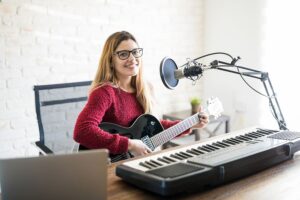Parents and students often ask us, “What is a virtual music lesson?”—and it’s a fair question. At its best, a virtual lesson isn’t just a video call with an instrument. It’s a well-structured, interactive learning experience led by a real teacher who sees and hears your child in real time, adjusting technique, offering feedback, and customizing instruction to fit their goals and personality.
Just like our in-person sessions, a great online lesson starts with a clear routine: warm-ups, technique building, song application, and time for questions or creativity. And when it’s done well, the results can be just as meaningful.
Structure and Feedback Make the Difference
Whether your child is learning piano, guitar, or voice, private online music lessons follow many of the same fundamentals as in-home sessions. For example, when we teach piano online, we’ll often use digital sheet music, screen sharing, and visual posture checks—just like we do in-person. If you’ve ever read our post on teaching chord charts to younger piano students, you’ll notice the same step-by-step clarity applies here too.
Real-time feedback is the heart of a successful virtual lesson. Teachers may demonstrate a passage, then watch the student try it. If necessary, they’ll adjust breathing, hand shape, or articulation. That instant connection is what sets private instruction apart—on or off screen.
Why Families Choose Virtual Lessons
- They save time. No traffic, no rushing—just logging in and starting.
- They’re flexible. Families can take lessons even while traveling or juggling multiple children.
- They build independence. Students take more ownership when they manage their own setup and practice flow.
These lessons also integrate beautifully with modern tools. Using platforms like Zoom or Google Meet, we can play backing tracks, annotate music, or even bring in learning games. Research from organizations like Yamaha Music USA supports what we’ve seen for years—virtual music education, when thoughtfully delivered, helps students grow creatively and confidently.
Tips for a Great Virtual Lesson Setup
- Use a stable device and internet connection. A laptop or tablet with a stand works best.
- Position the camera to show posture and hands. Especially important for piano and guitar.
- Keep music and materials ready. Digital or printed copies are both fine—just don’t scramble mid-lesson!
- Create a quiet, well-lit space. Fewer distractions make for smoother sessions.
If your child is shy or anxious about being on camera, we recommend starting with shorter sessions and celebrating small wins. You’ll be amazed how quickly their confidence grows.
FAQ – What to Know About Virtual Music Lessons
Q: Are online lessons as effective as in-person ones?
A: They can be! The key is consistency, clear instruction, and teacher connection—things our team prioritizes in every session.
Q: Can you teach beginners virtually?
A: Yes, and we do it all the time. Virtual lessons work well for brand-new students, especially when paired with visual tools and step-by-step guidance.
Q: What instruments are best for online lessons?
A: Piano, voice, guitar, and ukulele all work beautifully. We’ve even taught trumpet and violin online with great results.
